Sesquicentennial
History, part 5
The
Challenges of the Twentieth Century, 1921-1991
As the congregation celebrated
the dedication of its new sanctuary in 1921, it continued to
grow. Its membership of over 500 persons by the mid-1920s was
ably served by Dr. Henry James Lee
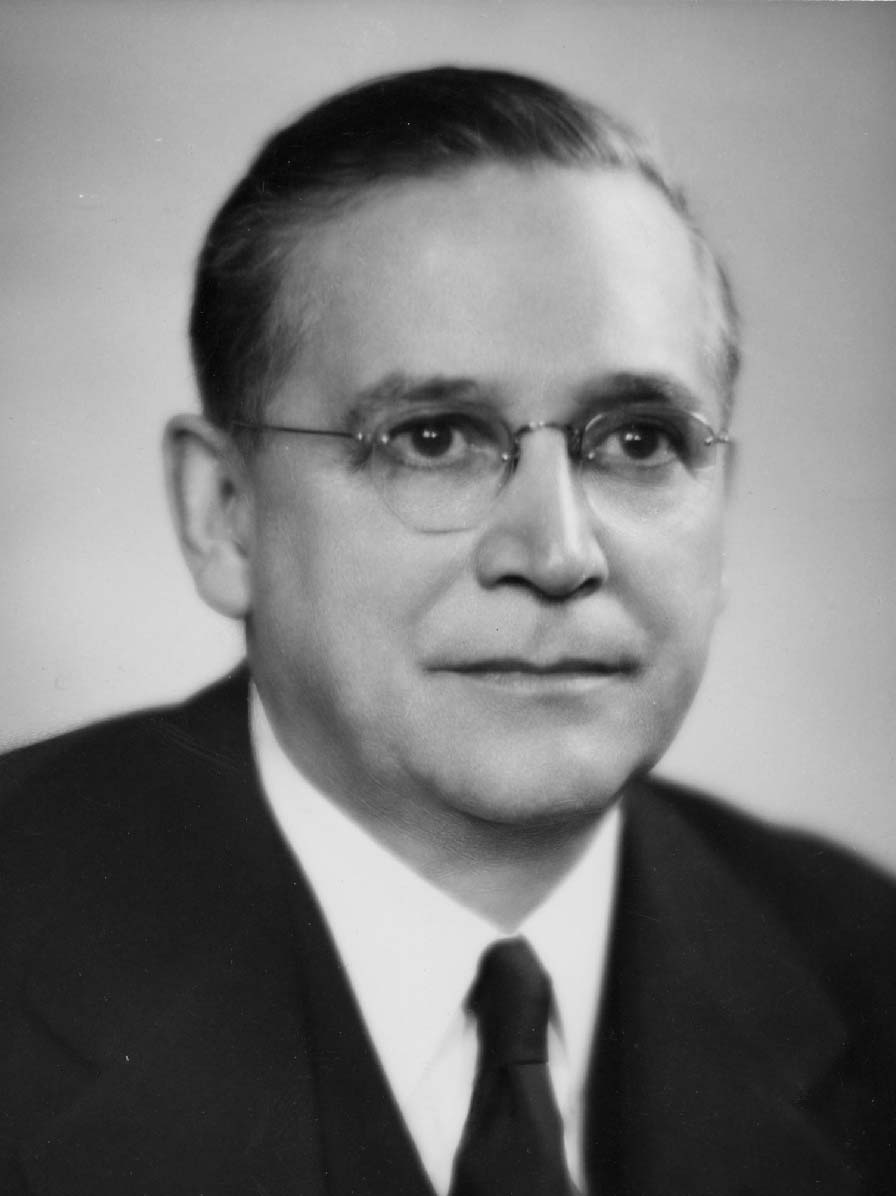 from 1925 to 1952.
Reminiscences of church members of this period recall Dr. Lee's
energy in ministering, single-handedly, to such a large
congregation and especially dwell on his ministry to the
congregation's youth. He even led Sunday afternoon hikes into the
nearby countryside where Wauwatosa boys still maintained a
swimming hole on the site of Hoyt Park. Dr. Lee also sponsored
Saturday evening dances for the congregation's youth in the
Church's new facilities, although such festivities always ended
promptly at midnight with the onset of the Sabbath. He added much
else to the life of the congregation, too, introducing robes for
the pastor and the choir for the first time and instituting in
1935 the now-traditional midnight Christmas Eve service.
from 1925 to 1952.
Reminiscences of church members of this period recall Dr. Lee's
energy in ministering, single-handedly, to such a large
congregation and especially dwell on his ministry to the
congregation's youth. He even led Sunday afternoon hikes into the
nearby countryside where Wauwatosa boys still maintained a
swimming hole on the site of Hoyt Park. Dr. Lee also sponsored
Saturday evening dances for the congregation's youth in the
Church's new facilities, although such festivities always ended
promptly at midnight with the onset of the Sabbath. He added much
else to the life of the congregation, too, introducing robes for
the pastor and the choir for the first time and instituting in
1935 the now-traditional midnight Christmas Eve service.
Henry James Lee's energies and
abilities, and those of the congregation's lay leaders, were
severely tested after 1929 by a number of events, the first of a
series of challenges that would mark the entire twentieth
century. Debt for the construction of the new Church still
encumbered the congregation when the New York Stock Exchange
crash of 1929 opened a decade of economic depression. Church
revenues declined with the national economy, and 1935 closed with
some unpaid bills. Church financial problems persisted for some
years, but in 1942, in honor of its Centennial, the Church was
able to burn its mortgage thanks to the efforts of William J.
Grede and his Debt Retirement Committee.
The years of the Depression
gave way to the war years of the 1940s. The Second World War
affected the Congregation far more deeply than had the First
World War. In 1917 and 1918, 53 members of the congregation
served in the armed forces but none lost their lives. In
1941-1945, 204 members served, and 12 died in the nation's
service.
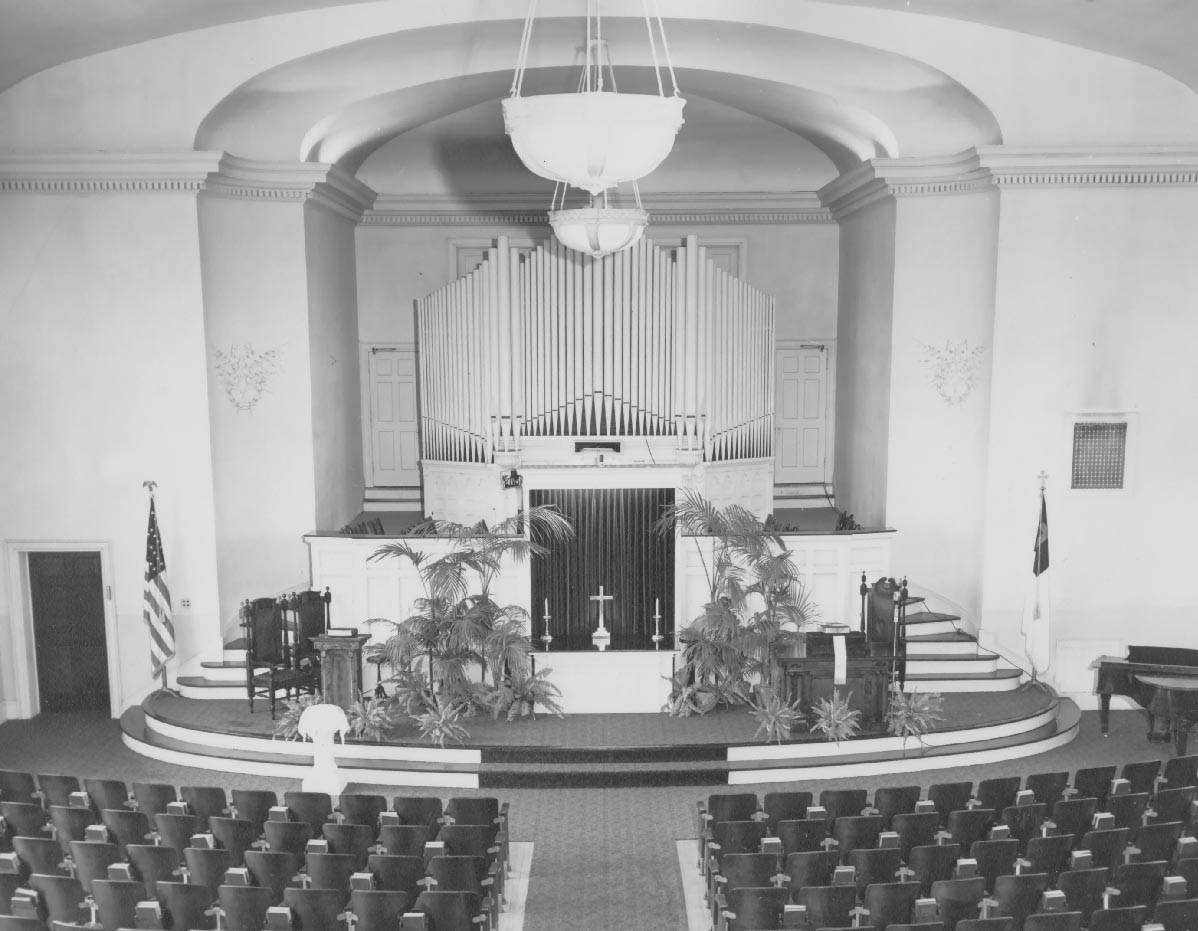 (Note: The Nave was changed to introduce the center aisle formation and the communion table and cloth backdrop.)
(Note: The Nave was changed to introduce the center aisle formation and the communion table and cloth backdrop.)
The war years also produced the
beginnings of a major division in American Congregationalism in
which First Congregational Church played an important role. The
General Council of Congregational Christian Churches, carrying
forward the nineteenth-century impulse to realize greater
Christian unity, initiated merger talks with the Evangelical and
Reformed Church. That project would produce schism.
The two potential partners were
quite different, both in size and practice. American
Congregationalists in 1945 numbered 1,130,824 persons in 5,836
self-governing congregations that subscribed to no uniform creed.
The Evangelical and Reformed Church, itself the result of a
merger in 1934 of two Protestant groups of German origin, the
Reformed Church and the Evangelical Synod, had a membership of
695,971 persons in 3,806 churches. The Evangelical and Reformed
church had a centralized, presbyterical mode of church governance
and a creedal tradition. Nonetheless, negotiations between the
General Council of Congregational Christian Churches and the
Evangelical and Reformed Church proceeded and a "Basis of
Union" document emerged from those discussions in 1942.
Many Congregationalists found
the Union a move toward a Church with a central presbytery and a
uniform creed that was antithetical to the Congregational Way.
Such feelings were especially strong in First Congregational
Church. Dr. Lee, the associate minister who joined him in 1951,
the Reverend Neil Swanson,
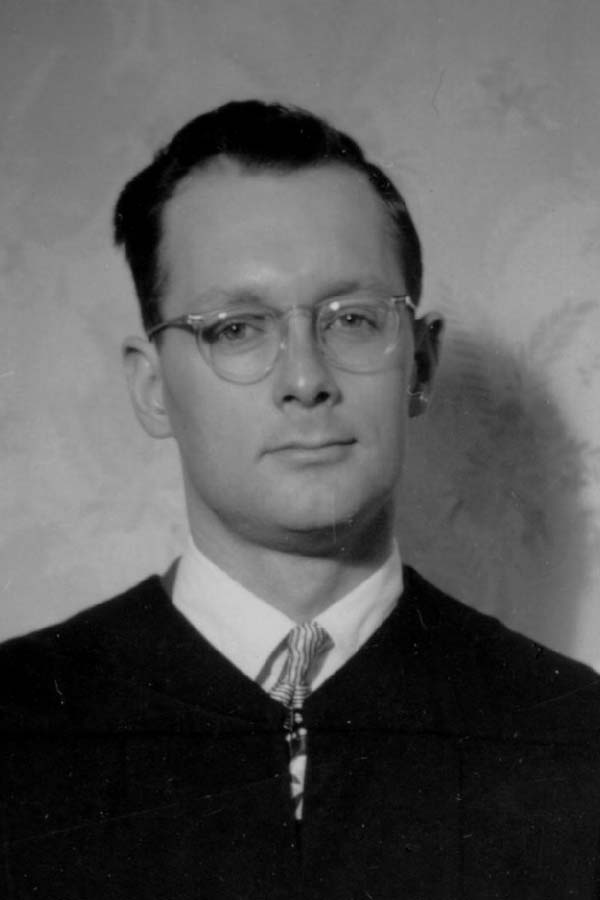 and the overwhelming majority of the
Church's members opposed the merger and the Church's annual
meeting in 1948 rejected the "Basis of Union". Many
other Congregationalists were like-minded. They joined members of
the Church in the League to Uphold Congregational Principles and
the Committee for the Continuation of Congregational Christian
Churches. In addition, Cadman Memorial Congregational Church in
Brooklyn, New York filed suit to challenge the merger efforts of
the General Council.
and the overwhelming majority of the
Church's members opposed the merger and the Church's annual
meeting in 1948 rejected the "Basis of Union". Many
other Congregationalists were like-minded. They joined members of
the Church in the League to Uphold Congregational Principles and
the Committee for the Continuation of Congregational Christian
Churches. In addition, Cadman Memorial Congregational Church in
Brooklyn, New York filed suit to challenge the merger efforts of
the General Council.
The Cadman case held up merger
plans for some years but when the courts finally dismissed the
suit, merger plans moved forward toward the creation of the
United Church of Christ (UCC). In order to provide an alternative
to the UCC, members of the League to Uphold Congregational
Principles, the Committee for Continuation of Congregational
Christian Churches, and other concerned Congregationalists met in
Detroit in 1955 to propose creation of the National Association
of Congregational Christian Churches (NACCC).
In Wauwatosa in this period
there were numerous meetings to determine First Church's stand in
all of this. Much of what follows is based on the reminiscences
of Neil Swanson. The Church drafted a new constitution in 1953
that reaffirmed Congregational principles. That constitution, as
subsequently amended, still guides the Church. Especially
noteworthy in this document was the creation of the office of lay
Moderator to guide the Church's operation. Then, in May 1956 the
congregation voted a resounding affirmation of traditional
Congregationalism by again rejecting the "Basis of
Union" by a vote of 259 to 9 and by voting 250 to 2 to join
the NACCC. In addition, First Congregational Church hosted the
October 1956 meeting that created the basic structure of the
NACCC, and the Church's Neil Swanson was selected as the NACCC
Moderator for 1957. Mr. Swanson served as Moderator in addition
to his duties here where he was ably assisted by his Associate
Minister, the Reverend John Alexander. Thus, while the majority
of Congregational Churches joined in launching the UCC in
Cleveland in 1957, First Congregational Church of Wauwatosa was
already playing a vital role in the founding of a religious
fellowship determined to maintain the Congregational Way. Today,
in 1992, the results of the efforts of these Congregationalists
stands as the NACCC with nearly 400 affiliated congregations.
The 1950s was a period of great
challenge for the Wauwatosa congregation in ways other than the
merger issue. The end of World War II brought a post-war
"baby boom" which swelled the youthful contingent of
the Church's membership throughout the 1950s and early 1960's.
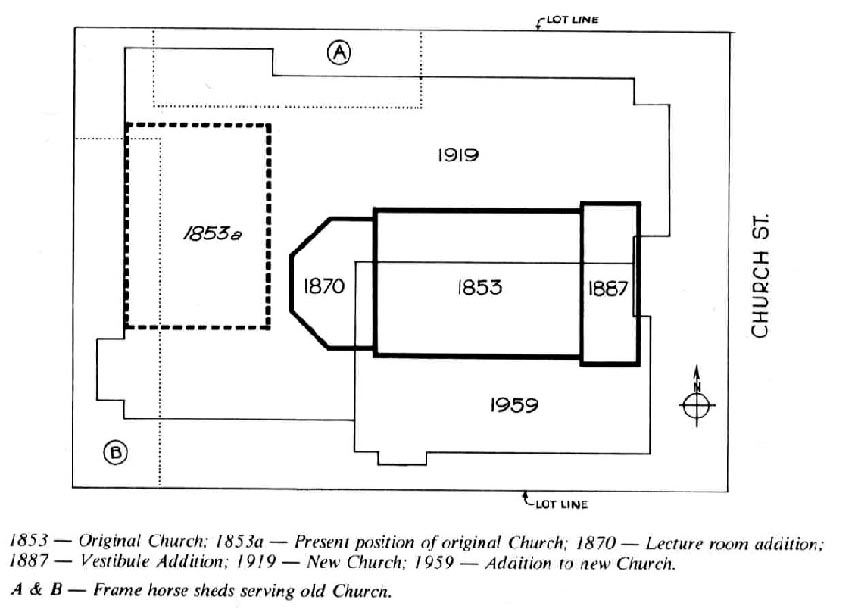 The pastoral staff expanded with the addition in 1951 of an
associate minister, a position first held by the Reverend Neil
Swanson. An 11:00 Sunday School was added in 1952, Family Camp
became part of the Church's activities in 1955, and the
congregation's growth mandated physical plant changes proposed by
Dr. Lee in 1952. This major project, completed in 1959 at a cost
of $450,000,
provided additional office space, the Chapel
The pastoral staff expanded with the addition in 1951 of an
associate minister, a position first held by the Reverend Neil
Swanson. An 11:00 Sunday School was added in 1952, Family Camp
became part of the Church's activities in 1955, and the
congregation's growth mandated physical plant changes proposed by
Dr. Lee in 1952. This major project, completed in 1959 at a cost
of $450,000,
provided additional office space, the Chapel
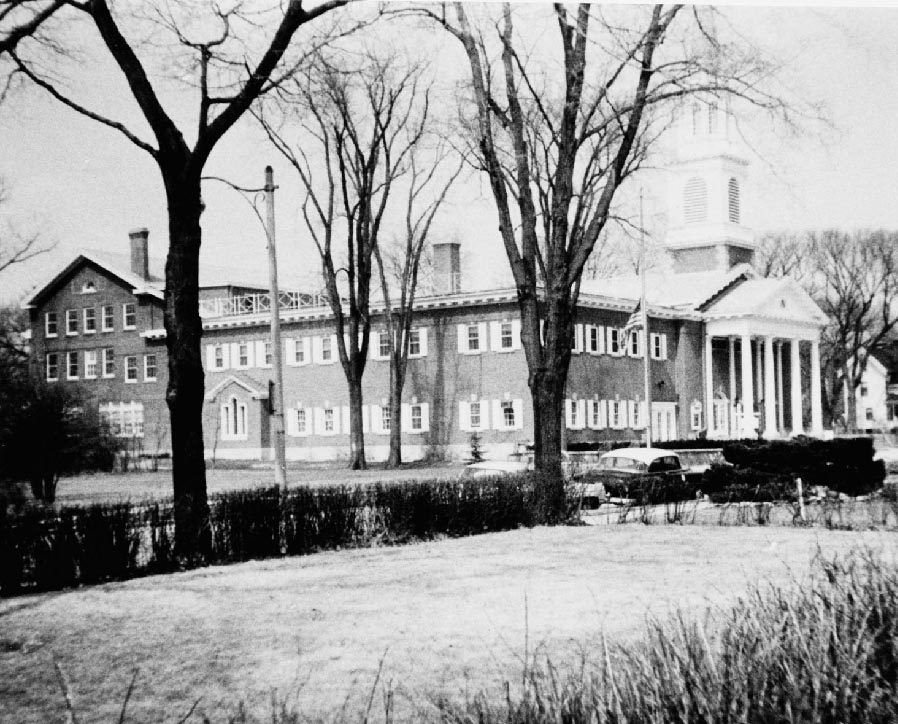 , a
remodeled social hall, and, most importantly, much-needed Sunday
School rooms.
, a
remodeled social hall, and, most importantly, much-needed Sunday
School rooms.
Such projects, amidst the
merger controversy, were made all the more challenging to the
congregation's leaders by several changes in its pastoral
leadership. Dr. Lee died tragically in an accident while visiting
his native England in 1952. His associate, Neil Swanson, ably
assumed the duties of Senior Minister, but his role
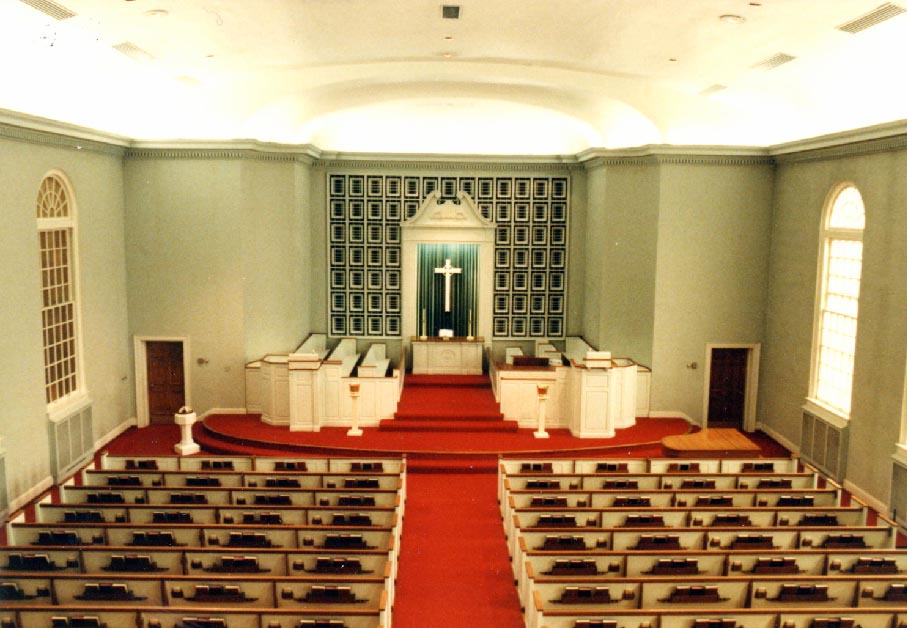 in the
founding of the NACCC led to his departure from our pulpit in
1958 to serve a six-year term as the first full-time Executive
Secretary of the NACCC. The final challenge of the 1950s was the
search for a new Senior Minister that successfully with the
calling of the Reverend Norman S. Ream.
in the
founding of the NACCC led to his departure from our pulpit in
1958 to serve a six-year term as the first full-time Executive
Secretary of the NACCC. The final challenge of the 1950s was the
search for a new Senior Minister that successfully with the
calling of the Reverend Norman S. Ream.
Dr. Ream's ministry in
Wauwatosa extended from 1958 until 1983. As one of the longest
pastorates in the Church's history, Dr. Ream's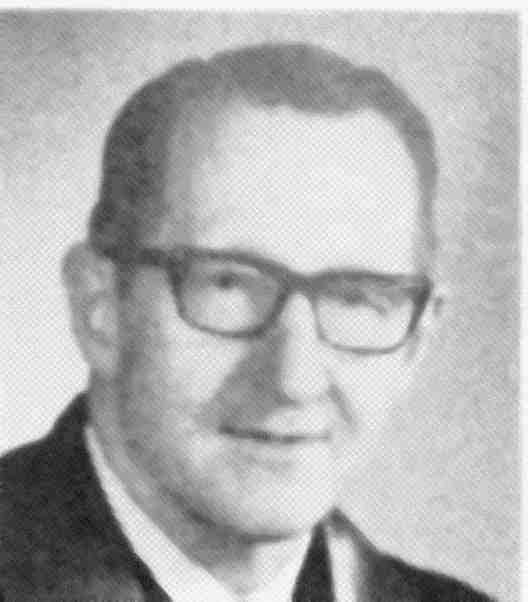 ministry proved to
be very influential in shaping First Congregational Church. The
population served by the Church was beginning to change by the
early 1960s. The post-war "Baby Boom" was over and the
average age of the American population was beginning a rise that
would continue for the rest of the twentieth century. Dr. Ream
early recognized this demographic trend and his ministry soon
reflected a new emphasis. In 1960 Dr. Ream initiated the idea for
a retired men's club to provide intellectual and spiritual
stimulus to an ecumenical group of retired men in the community.
The result was the Wauwatosa Retired Men's Club that continues to
meet in First Congregational Church on the first and third
Tuesdays of the month and which has a membership of over 400.
ministry proved to
be very influential in shaping First Congregational Church. The
population served by the Church was beginning to change by the
early 1960s. The post-war "Baby Boom" was over and the
average age of the American population was beginning a rise that
would continue for the rest of the twentieth century. Dr. Ream
early recognized this demographic trend and his ministry soon
reflected a new emphasis. In 1960 Dr. Ream initiated the idea for
a retired men's club to provide intellectual and spiritual
stimulus to an ecumenical group of retired men in the community.
The result was the Wauwatosa Retired Men's Club that continues to
meet in First Congregational Church on the first and third
Tuesdays of the month and which has a membership of over 400.
At Dr. Ream's instance the
Church undertook an even greater step at the 1966 Annual Meeting
when it voted to study the feasibility of founding a home for the
aged. That study progressed as the Church observed its
one-hundred and twenty-fifth anniversary in 1967, and its
positive conclusions led the Church to assume a whole new kind of
ministry at its 1967 Annual Meeting.
By 1972 the Church had
purchased property for the home, plans for it were approved, and
William Grede and Don Haberman led a successful $800,000 pledge
drive to begin construction for a facility that received its
first residents in January 1974. The Congregational Home has
proved to be quite successful: it has grown to fiscal
independence of the Church, and its popularity has led to several
expansions of the original facility. By 1992 the Congregational
Home offered several living options to the aged: one and
two-bedroom apartments, single rooms, supervised single room
services for those in need of some assistance, and a health
center with skilled nursing care.
During the Ream pastorate, the
Church extended its ministry in other ways, too. Assistance from
First Congregational Church facilitated the gathering of
Mayflower Congregational Church in Milwaukee's northern suburbs
in 1965. And in 1975 similar assistance made possible the
gathering of Lake Country Congregational Church in Hartland.
Indeed, the Wauwatosa Church's associate minister, the Reverend
Richard Liles, served in 1975-1976 as part-time minister of the
Lake Country Church until that congregation could call its own
pastor. Fellowship closer to home did not escape the Church's
attention, either, in the late 1960s, a period marked by deep
divisions in America society as a result of the war in Vietnam.
In 1967 the Church instituted the 10:00 A.M. second-Sunday coffee
hour to provide fellowship between a membership that found itself
somewhat separated into 9:00 and 11:00 congregations.
The physical plant of the
Church was also the object of the congregation's attentions
during the Ream ministry. In 1967 the Church purchased the
property immediately north of its building and there constructed
a parking lot the following year. In that year, 1968, the
Church's steeple also received extensive repairs and, for the
first time, complete lighting, making it a worthy home for the
Ruth Godfrey Davidson Bells that were added in 1974. Further
improvements came in 1981 on a Church that received landmark
status in 1980. At a cost of $350,000 the Church created a north
entrance facing an improved parking lot, the Friendship Lounge
with a serving kitchen, a completely renovated kitchen on the
second floor, and improved nursery facilities.
When Dr. Ream's ministry ended
in 1983 after a celebration in honor of his work at First
Congregational Church, the congregation called Dr. Philip Muth
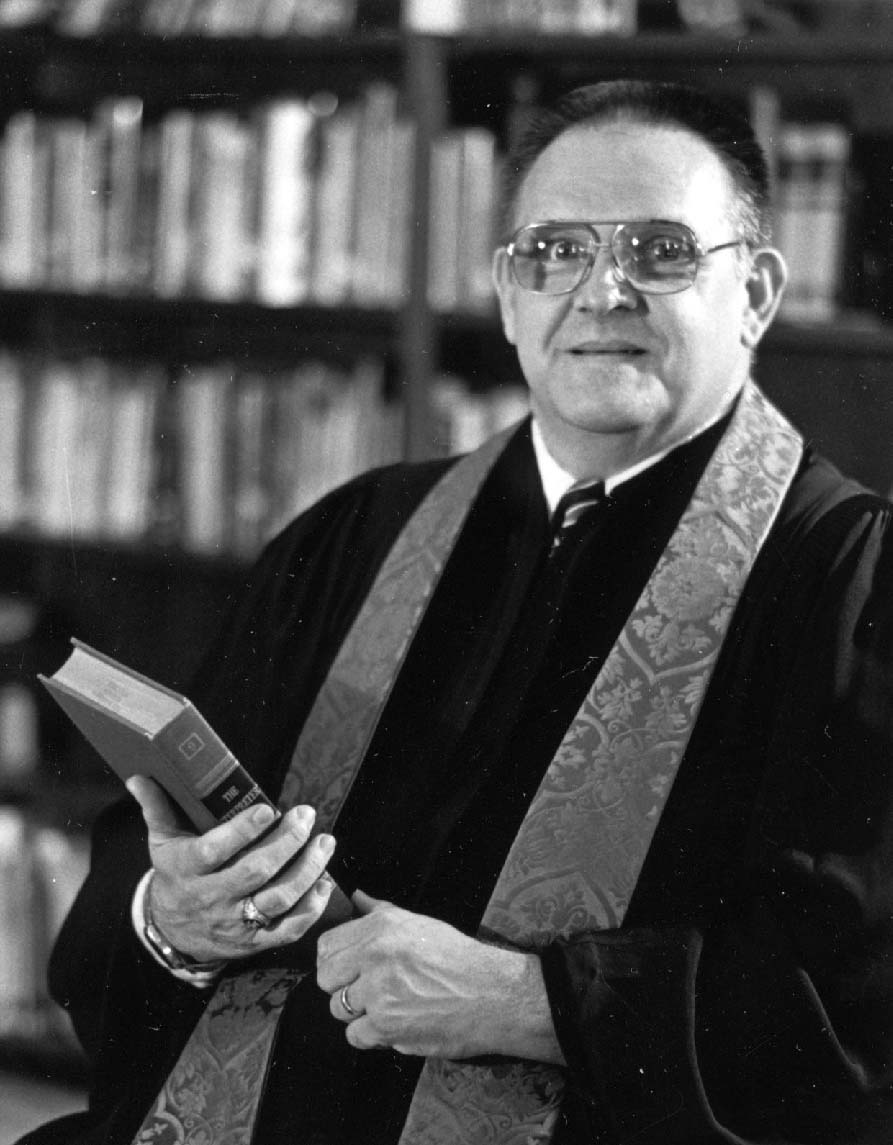 of
the Storrs, Connecticut, Congregational Church as its next
pastor. Dr. Muth arrived in June 1983 and for some time served
the large congregation without associate ministers because Dr.
Ream's retirement had been accompanied by other pastoral
departures. But in the course of 1984, the Reverend Markham Dunn
and the Reverend Jeff Palmer joined the Church as Associate
Ministers. Mr. Palmer was succeeded in his youth and fellowship
ministry by the Reverend John Currier in 1986 and by the Reverend
Richard Koch, a son of the congregation, in 1990. Mr. Dunn
of
the Storrs, Connecticut, Congregational Church as its next
pastor. Dr. Muth arrived in June 1983 and for some time served
the large congregation without associate ministers because Dr.
Ream's retirement had been accompanied by other pastoral
departures. But in the course of 1984, the Reverend Markham Dunn
and the Reverend Jeff Palmer joined the Church as Associate
Ministers. Mr. Palmer was succeeded in his youth and fellowship
ministry by the Reverend John Currier in 1986 and by the Reverend
Richard Koch, a son of the congregation, in 1990. Mr. Dunn
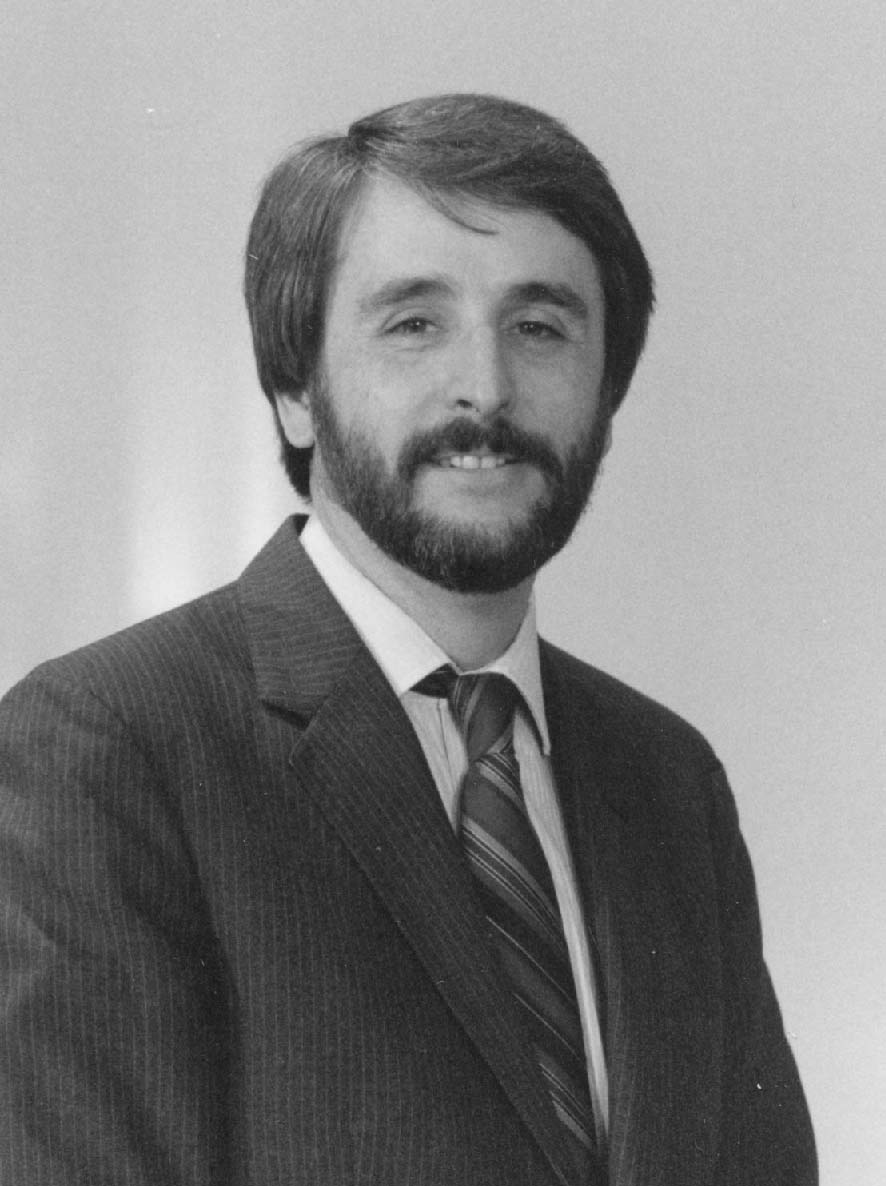 continued until 1991, when his pastoral counseling work was taken
up by
continued until 1991, when his pastoral counseling work was taken
up by
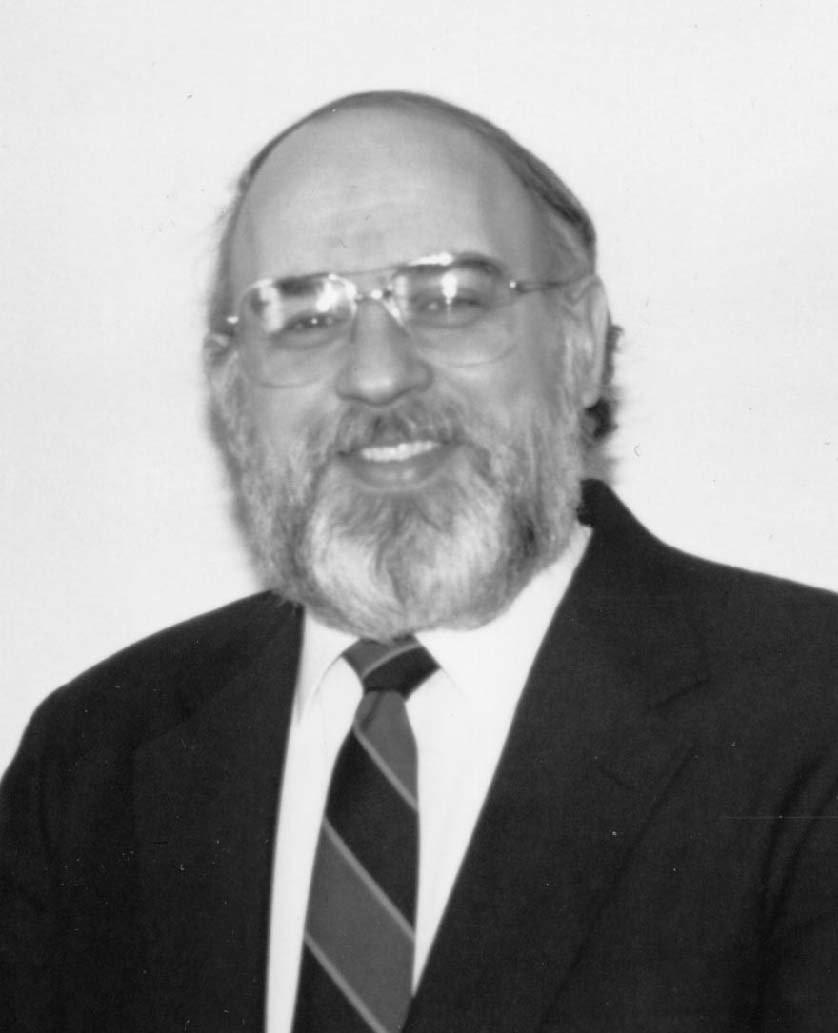 Dr. John Strassburger.
Dr. John Strassburger.
In the years of the Muth
ministry the congregation continued to be an active one. In 1987
the nave of the Church received an extensive renovation, and the
congregation continued to be one whose influence manifested
itself far
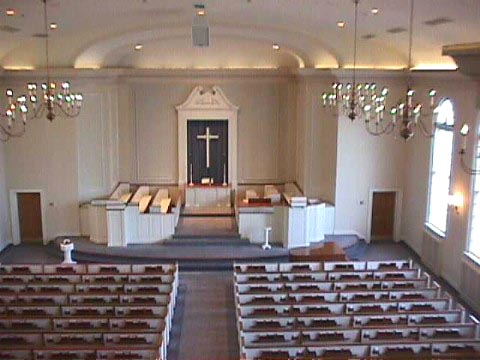 beyond Wauwatosa. Dr. Muth summed up the
congregation's spirit in noting that "This congregation can
do anything it sets it mind to." Programs in which Church
members support the Laubach Literacy Program, and provide meals
for the less fortunate through the St. Vincent de Paul meal
program on Milwaukee's near South Side continued. In 1988 the
congregation entirely financed construction of a $34,000 medical
clinic at the NACCC mission in Honduras, and has continued to
sustain the operation of that facility with its benevolence. And
in 1991-1992 congregation members completely renovated an inner
city, Milwaukee home at 2212 North 36th Street with their
contributions of labor and funds through the Habitat for Humanity
program. Sadness marked the life of the Church, too, when one of
its sons, Scott Schroeder, gave his life in the American and
Allied action against Iraq in January 1991.
beyond Wauwatosa. Dr. Muth summed up the
congregation's spirit in noting that "This congregation can
do anything it sets it mind to." Programs in which Church
members support the Laubach Literacy Program, and provide meals
for the less fortunate through the St. Vincent de Paul meal
program on Milwaukee's near South Side continued. In 1988 the
congregation entirely financed construction of a $34,000 medical
clinic at the NACCC mission in Honduras, and has continued to
sustain the operation of that facility with its benevolence. And
in 1991-1992 congregation members completely renovated an inner
city, Milwaukee home at 2212 North 36th Street with their
contributions of labor and funds through the Habitat for Humanity
program. Sadness marked the life of the Church, too, when one of
its sons, Scott Schroeder, gave his life in the American and
Allied action against Iraq in January 1991.
Celebration of the Church's
Sesquicentennial in 1991-92 also prompted the congregation to
closely consider its future in a comprehensive long range
planning effort. Throughout the twentieth century the Church
successfully has answered new challenges. It stands in its 150th
year as a testimony to the strength of the Congregational
tradition, and its vitality readily is apparent in its many
endeavors in its Sesquicentennial year.
Back to History Page:
A
Sesquicentennial History

 from 1925 to 1952.
Reminiscences of church members of this period recall Dr. Lee's
energy in ministering, single-handedly, to such a large
congregation and especially dwell on his ministry to the
congregation's youth. He even led Sunday afternoon hikes into the
nearby countryside where Wauwatosa boys still maintained a
swimming hole on the site of Hoyt Park. Dr. Lee also sponsored
Saturday evening dances for the congregation's youth in the
Church's new facilities, although such festivities always ended
promptly at midnight with the onset of the Sabbath. He added much
else to the life of the congregation, too, introducing robes for
the pastor and the choir for the first time and instituting in
1935 the now-traditional midnight Christmas Eve service.
from 1925 to 1952.
Reminiscences of church members of this period recall Dr. Lee's
energy in ministering, single-handedly, to such a large
congregation and especially dwell on his ministry to the
congregation's youth. He even led Sunday afternoon hikes into the
nearby countryside where Wauwatosa boys still maintained a
swimming hole on the site of Hoyt Park. Dr. Lee also sponsored
Saturday evening dances for the congregation's youth in the
Church's new facilities, although such festivities always ended
promptly at midnight with the onset of the Sabbath. He added much
else to the life of the congregation, too, introducing robes for
the pastor and the choir for the first time and instituting in
1935 the now-traditional midnight Christmas Eve service.




 ministry proved to
be very influential in shaping First Congregational Church. The
population served by the Church was beginning to change by the
early 1960s. The post-war "Baby Boom" was over and the
average age of the American population was beginning a rise that
would continue for the rest of the twentieth century. Dr. Ream
early recognized this demographic trend and his ministry soon
reflected a new emphasis. In 1960 Dr. Ream initiated the idea for
a retired men's club to provide intellectual and spiritual
stimulus to an ecumenical group of retired men in the community.
The result was the Wauwatosa Retired Men's Club that continues to
meet in First Congregational Church on the first and third
Tuesdays of the month and which has a membership of over 400.
ministry proved to
be very influential in shaping First Congregational Church. The
population served by the Church was beginning to change by the
early 1960s. The post-war "Baby Boom" was over and the
average age of the American population was beginning a rise that
would continue for the rest of the twentieth century. Dr. Ream
early recognized this demographic trend and his ministry soon
reflected a new emphasis. In 1960 Dr. Ream initiated the idea for
a retired men's club to provide intellectual and spiritual
stimulus to an ecumenical group of retired men in the community.
The result was the Wauwatosa Retired Men's Club that continues to
meet in First Congregational Church on the first and third
Tuesdays of the month and which has a membership of over 400.


